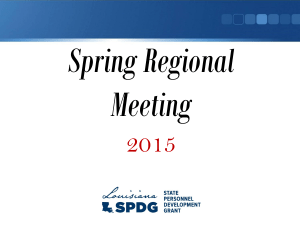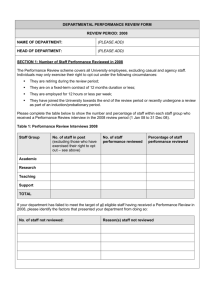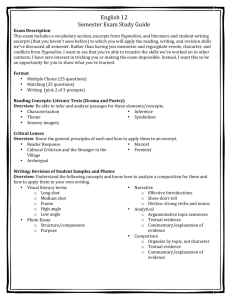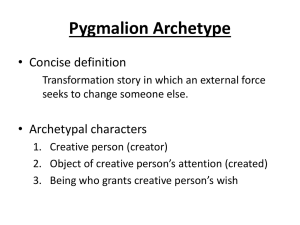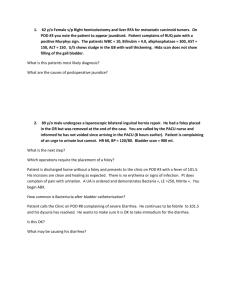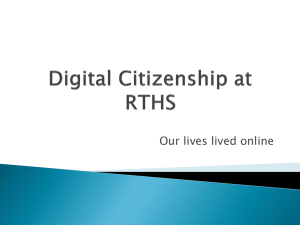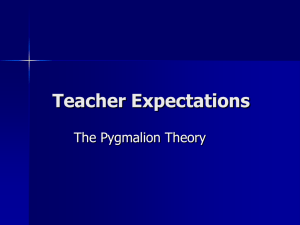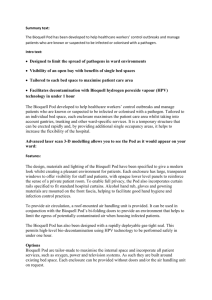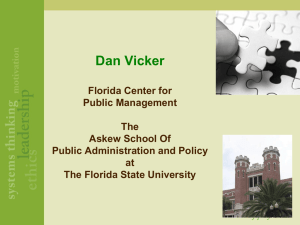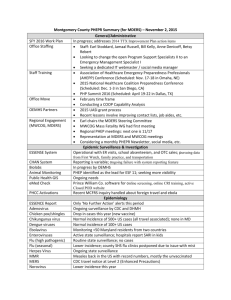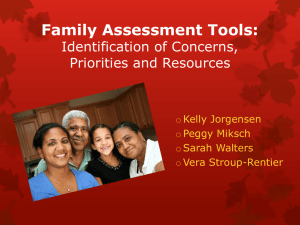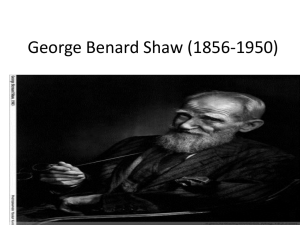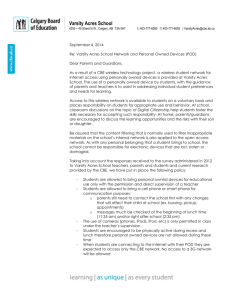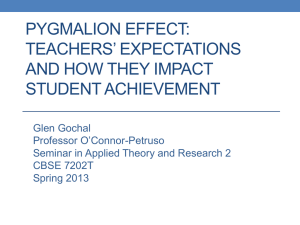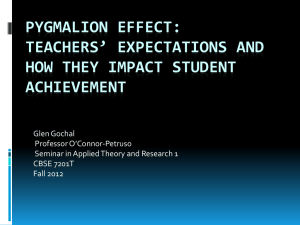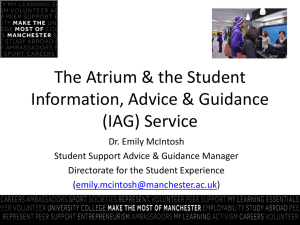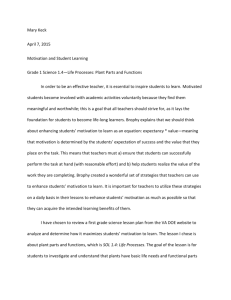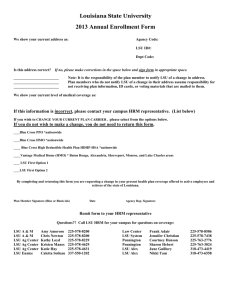Creating a Classroom Culture of High Expectations
advertisement
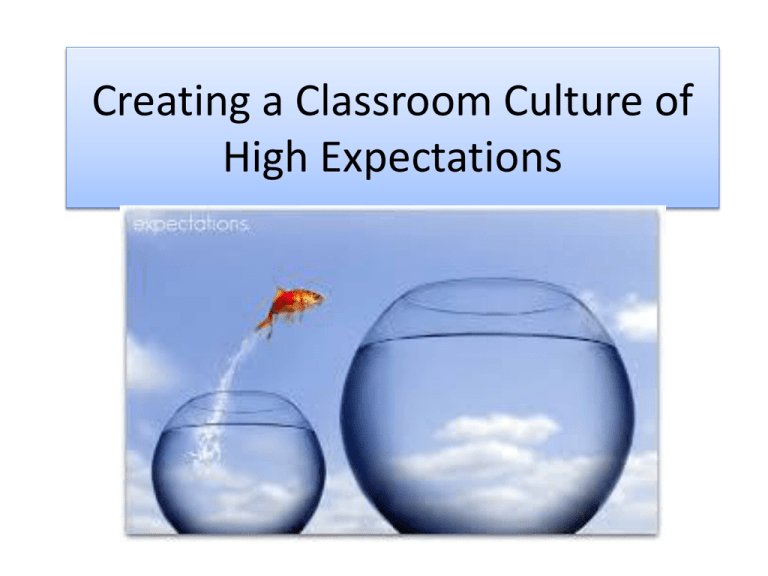
Creating a Classroom Culture of High Expectations Attendance • At this time, if you have not already done so, please use your chat pod and type the district/LEA you are representing • If you are viewing this webinar with others in the room, please indicate their name as well Considerations • This webinar is being recorded and will be available for viewing at www.laspdg.org under Culturally Responsive Practices Webinars 2013-2014 • If you need to ask a question, please use the Chat Pod on your screen (NOTE: everyone can see your question) • You can download all of today’s materials in the FILES 2 Pod on your screen at any time during the presentation – Click on the selected file – Choose “SAVE TO MY COMPUTER” – Select the destination where you would like to save the file People First Language “People First Language puts the person before the disability and describes what a person has, not who a person is.” Kathie Snow. (n.d.) A few words about People First Language. Disability is Natural. Retrieved August 1, 2012 from http://www.disabilityisnatural.com/images/PDF/pfl-sh09.pdf • Gain knowledge of the importance of high expectations in the classroom • Gain knowledge of students’ responses to high expectations • Gain knowledge of examples of high expectations in the classrooms 5 What do you already know? In an effort to better understand participant knowledge level, please take a moment to answer these pre-questions that will appear on your screen: Vocabulary • Teacher Expectations are inferences or assumptions made about future student behavior. Teacher Expectations • have both a positive and negative effect on student learning and achievement • influence the ways in which teachers evaluate students, behave toward students, and make decisions about students Good, T. L., & Brophy, J. E. (2003). Looking in classrooms (9th ed.). Pygmalion Effect • asserts that “ones expectations about a person can eventually lead that person to behave and achieve in ways that confirm those expectations” Rosenthal & Jacobson (1968) Behaviors That Teachers Display for High and Low Expectations Teacher Behavior for Students with High Expectations • Praise students for success and less likely to criticize for failure in classroom task • Offer feedback on assignments at a higher rate • Correct and probe for students to answer questions • Criticism as a means of communicating high standards • Grading-given the benefit of the doubt Good and Weinstein (1986): General Dimensions of Teachers’ Communication of Differential Expectations Teacher Behavior for Students with Low Expectations • • • • • • • • • Wait less time for students to answer questions More likely to give the answer than probe Tend to reward inappropriate or incorrect responses Pay less attention/or do so privately more often than publicly Call on less frequently Seat student further away Smile less/less eye contact Offer less learning material Criticism as a means of degrading them, cutting them off from attempts to complete work Good and Weinstein (1986): General Dimensions of Teachers’ Communication of Differential Expectations Teacher Behavior-Effect on Learning • Widen the gap between low and high achieving students • Affect students’ own beliefs about their competencies Student Responses To Expectations Student Passivity • Defined-inactive; a lack of initiative • Due to students being called on less often, teachers giving answers, students having a shorter wait time and students not likely to have the correct response. Silent Students Why? • Personal anxiety or anticipation of possible embarrassment • Low self-confidence vs. low knowledge • Cultural reasons • Prefer to learn by listening and thinking Silent Students: Perspectives on More Verbal Classmates • Irritating • Self-Centered • Keeping others from having a turn • Smart (know it all) Rosenthal, R. (1991). Teacher expectancy effects: A brief update 25 years after the Pygmalion experiment. Journal of Research in Education Self-Fulfilling Prophecy • Defined -- The process by which a person’s expectations about someone can lead to that someone behaving in ways which confirm to the expectations • Pygmalion in the Classroom -- Research by Rosenthal and Jacobson Students’ Perceptions of Teacher Expectations • Expectations, either high or low, can become a self-fulfilling prophecy. • Teachers’ beliefs about student potential are particularly powerful for students of color and students from poor families. Lisa Delpit (2012). Multiplication is for White People High Expectations • High expectations is both a belief about student capability and specific actions undertaken to make those beliefs a reality. High Expectations Response Opportunity Personal Regard Feedback Response Opportunities • Individual Help • Probing, Rephrasing, and Clues • Wait Time • Equitable Response Opportunities • Higher Level Questions Interactions that Facilitate High Expectations: Wait Time • Students who volunteer to answer will increase as will the length of their responses • Responses will demonstrate critical thinking supported by evidence or logic http://www.youtube.com/watch?v=dBnuSUL0ymM Equitable Response Opportunities • The number of times teachers call on students is directly related to the level of expectations they have for them • Teachers call on students when they have confidence in their ability to answer a question • Teachers call on less students in whom they have little confidence http://www.youtube.com/watch?v=1W0Yrk3GZ_U Interactions that Facilitate High Expectations: Questioning • Leveling questions is a good practice, it helps students to stretch their thinking • Rephrase questions to aid students understanding • Give students clues rather than pass over them Interactions that Facilitate High Expectations: Questioning • If students are only asked questions that require low levels of intellectual involvement they will tend to think accordingly • Students who are given questions based on higher levels of thinking will tend to think more creatively Interactions that Facilitate High Expectations: Bloom’s Taxonomy Knowledge • Recall information Comprehension • Ideas are organized Application Analysis Synthesis Evaluation • Take knowledge and apply it • Identify reasons, causes or motives • Produce original ideas and solve problems • Make judgment about something Bloom’s Taxonomy Higher Order Thinking Skills (HOTS) Lower Order Thinking Skills (LOTS) Comprehension Knowledge Evaluation Synthesis Analysis Application http://www.youtube.com/watch?v=CW8JQfjmhCE&feature=youtu.be Personal Regard • • • • Proximity Courtesy Touch Personal Interest Interactions that Facilitate High Expectations: Proximity • Proximity communicates value • Provides the teacher an opportunity to develop a bond with each individual Interactions that Facilitate High Expectations: Touching • • • • Shake hands High five Thumbs up Smile Boynton & Boynton (2005) Educator's Guide to Preventing and Solving Discipline Problems http://vimeo.com/41421052 Interactions that Facilitate High Expectations: Personal Interest • Incorporating students’ personal interests into academics • Noticing individual accomplishments and important events in students' lives • Interacting with students as individuals Good, T. L., & Brophy, J. E. (2003). Looking in classrooms (9th ed.). http://youtu.be/xNIJCs0U1PM Expectations and Support • Increase expectations without helping students achieve success almost always leads to frustration and failure Feedback • Affirm or Correct Response • Praise Performance • Give Reason For Praise • Listen Attentively • Accept and Reflect Feelings Feedback: Grading Strategy • What does an “F” really mean? • Grading: A, B, C, and NY (Not Yet!) communicates what is expected from students Feedback with Families • Effective teachers produce and share progress reports and grades weekly with families and students • Reaffirms the teachers and families approach to students learning Porterfield & Carnes (2012) Why Social Media Matters Feedback • Beginning and ending every instructional segment with a review of past learning and the big picture • Inspiring students to probe “why?” and “how do you know that you know?” • Requiring students to express their thinking and learning through speaking, writing and designing Feedback • Students need constant feedback on how well they are performing • Feedback is a two way proposition High Expectations Response Opportunity Personal Regard Feedback Building Capacity • When you leave today, what will you do with this information? • How will you share it with others in your district? • When will you share it? (Timeline) Note: If you are on the district leadership team, this information will be useful in completing your district’s LASPDG 5 Year Plan 45 Let’s Take a Poll! Please take a moment to answer these post-questions regarding your knowledge: Questions? Please use your chat pod if you have questions related to this presentation • You may email any questions to Summer Whitmore swhitm1@lsu.edu Upcoming Webinars *February 19 @ 10 am- Inclusive Practices 10 Steps to Implementing Effective Inclusive Practices: A guide for Site Leaders http://connect.lsu.edu/ip10steps/ *February 26 @ 10 am- Data Based Decision Making Data Discovery: Placement-Educational Environment (Ages 6-21) http://connect.lsu.edu/dbdmplacement/ Thank you for participating in today’s webinar! Resources and information provided by http://uncommonschools.org/ www.laspdg.org The contents of this PowerPoint presentation were developed under a grant from the US Department of Education, #H323A110003. However those contents do not necessarily represent the policy of the US Department of Education, and you should not assume endorsement by the Federal Government.
